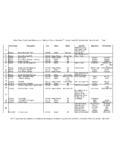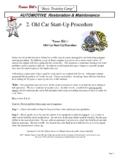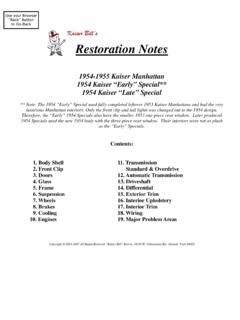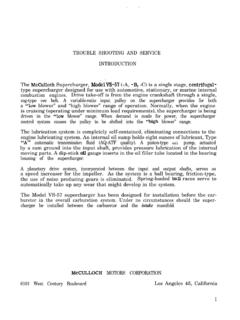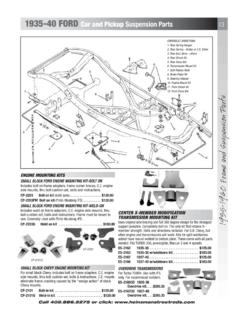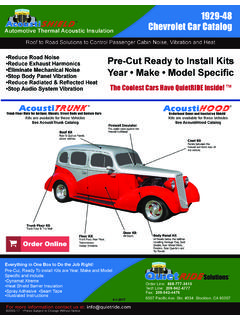Transcription of 1952-1953 Kaiser Special 1952-1953 Kaiser …
1 Restoration Notes 1952 -1953 Kaiser Special 1952 -1953 Kaiser Manhattan 1953 Kaiser Dragon 1954 Kaiser Early Special ** ** Note: The 1954 Early Special used fully completed leftover 1953 Kaiser Manhattans and had the very luxurious Manhattan interiors. Only the front clip and tail lights was changed out to the 1954 design. Therefore, the Early 1954 Specials also have the smaller 1953 one-piece rear window. Later produced 1954 Specials used the new 1954 body with the three-piece rear window. Their interiors were not as plush as the Early Specials. Special Note: The 1952 Kaiser Virginian Model is not covered here. Although this model is listed as a 1952 year model, they are really left-over 1951 cars that were re-serialized with 1952 serial numbers. Some of these cars had Continental Tire Kits installed by the factory while others had a two-tone paint scheme applied to them.
2 They are in fact 1951 cars in every respect except for the serial number and black plastic hood ornament Contents: 1. Body Shell 11. Transmission 2. Front Clip Standard & Overdrive 3. Doors 12. Automatic Transmission 4. Glass 13. Driveshaft 5. Frame 14. Differential 6. Suspension 15. Exterior Trim 7. Wheels 16. Interior Upholstery 8.
3 Brakes 17. Interior Trim 9. Cooling 18. Wiring 10. Engines 19. Major Problem Areas Copyright 2005-2007 All Rights Reserved Kaiser Bill Brown, 18530 W. Yellowstone Rd., Altonah, Utah 84002 PREFACE I have complied these Restoration Notes in order to provide some guidance to those who own these unique American automobiles and for those who may be contemplating purchasing one. The Kaiser automobiles were some of the most unique and quality American cars of the 1950's and are a very pleasurable car to own, restore, show or drive.
4 They turn heads every where they go and their beauty and uniqueness always draw a crowd. The Kaisers are not difficult to restore or maintain and most parts can be located with little effort. Most me-chanical parts were obtained from outside suppliers, such as Borg-Warner, Auto-Lite, and GM, so many parts are common with other makes. The engines were built by Kaiser but, since Kaiser also owned the Jeep line, the engines were used in the Jeep as well, even long after Kaiser had sold the Jeep line to AMC, so most engine parts are not that difficult to locate. However, there are several items, especially body and trim parts, which a prospective buyer should inspect carefully since replacements are extremely difficult to locate in us-able or restorable condition.
5 There items are identified in the detailed sections. The Kaiser organization introduced many features that would later be found on other cars. Kaiser produced the first Hatch-Back car, the first 4-door convertible, the first post-war supercharged car, the first Safety First car and introduced the bright color coordinated exteriors and interiors to the automotive industry. The Kaiser automobiles were given many international awards for beauty and style. Howard Darrin who designed the streamlined 1951-1955 Kaiser body lines was a famous world-class de-signer who designed many of the custom bodied luxury cars of the 1930's and 1940's for the European manu-facturers as well as the American car companies. His design of the was proba-bly his most memorable. It remains one of the best-looking cars to this day and is the most sought after Kai-ser I have been involved with the Kaiser and Frazer Automobiles since 1946.
6 My Dad was a Kaiser -Frazer-Willys Dealer from 1946 until 1956 and I worked in my Dad s shop after school and on Saturday s during my High School days and thereafter upon my return from military service. I now devote most of my time trying to help others by sharing what knowledge I have of these automobiles. These notes are by no means complete, and there may be some errors that I have not recognized, but I hope these Restoration Notes will be helpful to those who read them. NOTE: There are several sources of interchange parts lists, including the Hollander Interchange Manual. All of the known lists are helpful but none are totally accurate or complete for the Kaiser cars. Copyright 2005-2007 All Rights Reserved Kaiser Bill Brown, 18530 W. Yellowstone Rd.
7 , Altonah, Utah 84002 1. Body Shell: 4-Door Sedan Models - The 1952 , 1953 and 1954 4-door Specials shared the same body. It was basically the same as the 1951 4-door body except for very minor differences. The1952-54 front and rear bumper splash shields are different from the 1951 models and the 1953-54 rear fenders were drilled to accommodate the larger tail light housings and fins. The stainless bottom side trim mounting holes were drilled differently for the Specials and the Manhattans. The 1952 and 1953 4-door Manhattans shared the same body as the Specials. It was basically the same as the 1951 4-door body except for the very minor differences explained 2-Door Sedan Models - The 1952 , 1953 and 1954 2-door Specials shared the same body. It was basically the same as the 1951 2-door body except for the very minor differences as ex-plained for the 4-door above.
8 The 1952 and 1953 2-door Manhattans shared the same body as the Specials except the stainless bottom side trim mounting holes were drilled differently for the Specials and the Man-hattans Club Coupe - The 1952 Club Coupe body was unique to only that model but the body was ba-sically the same as the 1951 Club Coupe Deluxe (and Business Coupe) body except for very minor differences as explained for the 4-door above. The stainless bottom side trim mounting holes were drilled differently for the Specials and the Manhattans. This body style was pro-duced in the 1952 Business Coupe and Manhattan models. There were no 1953 or 1954 Club Coupes produced. The Club Coupe (and Business Coupe) is admittedly the best looking of the Kaiser bodies and the model most desired by collectors.
9 Note: The 1951 thru 1954 Kaisers were praised as the best looking American car. It was awarded many international awards for its beauty of design. Many of the exterior features of the 1951 thru 1954 Kaisers would soon be copied by every US car manufacturer. The rear fender Darrin Dip would first be copied by Chevrolet for the new 1955 Chevrolet. Almost every US car maker would soon copy this Dip. Ford would be the next to copy the Dip for the 1965 Mustang, Most others would soon follow. The rear window backward slant was also copied by many. The front and rear window Sweetheart shape would remain a unique Kai-ser design feature. Traveler - The 1952 and 1953 Kaiser Hatch-Back Traveler has a body unique to that model only. It was produced as both a 4-door and 2-door in the Deluxe and Manhattan models.
10 The 1951, 1952 and 1953 bodies are all the same except for the mounting holes for the side trim and the difference explained for the 4-door sedan bodies. The bodies are not interchangeable with any other model, however some patch panels may be cut from other Kaiser models, such as the rear quarters and the roof. The front window cut-out is the same but the rear window cut-out is different. There was no 1954 Traveler produced. Note: Kaiser produced the world s first Hatch-Back in 1949. This original Kaiser design was personally ordered built by Henry J. Kaiser himself. There is a interesting story as to the event that prompted Henry Kaiser to order this model to be put into production. Parts - A limited number of reproduction body parts are available. Reproduction outer rocker panels, partial floor panels and rear fender well repair panels are available.
